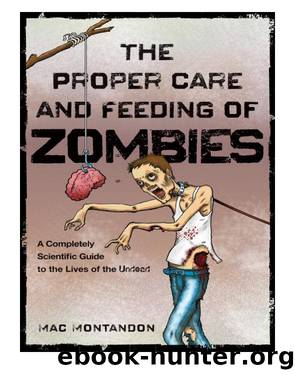The Proper Care and Feeding of Zombies by Mac Montandon

Author:Mac Montandon
Language: eng
Format: epub
Publisher: John Wiley & Sons, Ltd.
Published: 2010-09-10T00:00:00+00:00
That, my friends, is mind blowing! The deeper we go into sleep, the more our brain function is actually altered to resemble a nonthinking, hallucinating creature. A zombie deep in sleep is even more zombie than normal.
Neurologically speaking, in deep, or REM, sleep, the Hobson and Pace-Schott paper notes: âDifferent regions are . . . hyperactivated (the amygdala, paralimbic cortices and certain multimodal association areas) and deactivated (the dorsolateral prefrontal cortex).â As our friend Dr. Steven Schlozman has noted (and as we discussed in chapter 1)âzombies can be seen as little more than walking amygdalas, as that is the part of the brain that deals with and understands emotion and emotional responses. So, again, deep-sleeping zombies, it follows, would essentially be strengthening their zombie muscles while they doze. Hobson and Pace-Schott additionally point out that the amygdala transmits feelings of anxiety, which is why so many of us have dreams wherein we are soaring to dangerous heights or naked in front of strangers. It doesnât take too much imagination to see the undead as being extremely anxious, to the point of irritability, about where their next meal of flesh and bones is going to come from.
The Harvard fellasâ paper also observes that the dorsolateral prefrontal cortex (DPC) is âdeactivatedâ during REM sleep. This suggests a zombielike state yet again, for it is in the DPC that such brain-powered things a logical thinking and the ability to plan ahead come fromâour executive function, if you will. Qualities, Iâm sure weâd all agree, zombies have in short supply, as if their DPC were in a state of perpetual deactivation.
Of course much, if not all, of these fascinating discoveries will have very little bearing on the waking lives of zombies unless one is a believer in plasticity. The case for plasticity says that there is a relationship between the sleeping life of the brain and the waking brain, that the brain grows, develops, and changes at night, particularly during REM sleep. Proponents of this idea point to the amount of sleep that newborns require as, in part, proof that plasticity is a true and vital element of brain development. As Hobson and Pace-Schott remind us, âBrain activity in utero and in premature infants consists almost entirely of REM-sleeplike states.â
The paper cites a handful of studies done on rats and even kittens that indicate a connection between brain development and deep sleep. What we can take from these studies and the theory of plasticity is this: if we start with the idea that zombies have a functional brain and that is why we must shoot, batter, or otherwise inflict harm to their heads to slow them down, then we can see how a zombie who rests for seven to nine quality hours a night will be even more terrifying than he already is. The parts of the brain that are already active in the ghoulâspecifically the amygdalaâwill, it seems, develop even more, while the areas in which the ghoul is deficientâye olde dorsolateral prefrontal cortex and all that jazzâwither yet more.
Download
This site does not store any files on its server. We only index and link to content provided by other sites. Please contact the content providers to delete copyright contents if any and email us, we'll remove relevant links or contents immediately.
Still Foolin’ ’Em by Billy Crystal(36233)
Spell It Out by David Crystal(36014)
The Great Music City by Andrea Baker(31229)
Professional Troublemaker by Luvvie Ajayi Jones(29563)
Trainspotting by Irvine Welsh(21471)
Call Me by Your Name by André Aciman(20340)
We're Going to Need More Wine by Gabrielle Union(18927)
The Secret History by Donna Tartt(18788)
Cat's cradle by Kurt Vonnegut(15127)
Ready Player One by Cline Ernest(14473)
Molly's Game by Molly Bloom(14041)
Bombshells: Glamour Girls of a Lifetime by Sullivan Steve(13942)
The Goal (Off-Campus #4) by Elle Kennedy(13409)
Leonardo da Vinci by Walter Isaacson(13131)
4 3 2 1: A Novel by Paul Auster(12245)
The Social Justice Warrior Handbook by Lisa De Pasquale(12101)
The Break by Marian Keyes(9282)
Crazy Rich Asians by Kevin Kwan(9143)
Adultolescence by Gabbie Hanna(8809)
